Formation 1981 Notable members Endogonidia Tragedy Founded 1981 | Website raffaellosanzio.org Type of business Theatre group | |
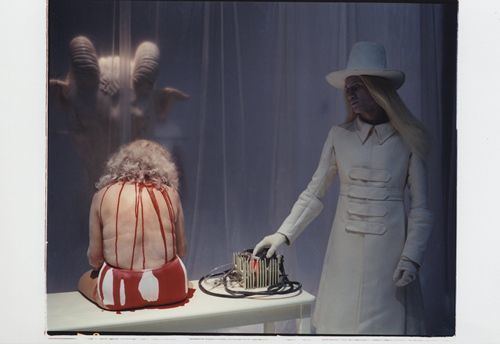 | ||
Membership Romeo and Claudia Castellucci; Chiara and Paolo Guidi Similar Chiara Guidi, Scott Gibbons, Franco Pistoni, Carmelo Bene, Gianandrea Gazzola | ||
The Socìetas Raffaello Sanzio (SRS) is an Italian experiential theater company founded in 1981. Its initial development was part of movement in Italian theater which did not require a background in theater but was influenced by rock, poetry, comics, television and more. By the end of the 1990s, the work done by this group had influenced a number of newer groups, winning awards for various works. The performances of this company shuns conventional coherent narrative and focuses more on visual and auditory impact, using silences, word fragments and even animals and machines as performers. The company is based in Cesena, near Bologna, Italy where it has its own theater, but it has performed in various venues in Europe and in Mexico.
Contents
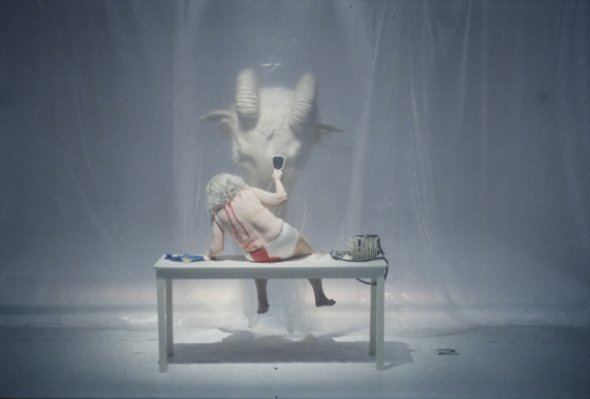
History

Socìetas Raffaello Sanzio was founded by two pairs of siblings, Romeo and Claudia Castellucci, and Chiara and Paolo Guidi when all were still teenagers. In 1979, members of the future company attended a performance by Italian theater company Magazzini Criminali (Criminal Warehouse). According to them, they were prompted to dedicate themselves to theater as they, especially Romeo Castellucci, opposed the museum-like quality of the performance, which lacked movement. The group first performed their first work at an apartment in Rome in November 1980, officially founding the company the following year, in Cesena, Italy, (near Bologna) first named Gruppo Espressione and then Esplorazineo Teatro. The young company embraced the Gesamtkunstwerk aesthetic, and originally all productions were written by members.
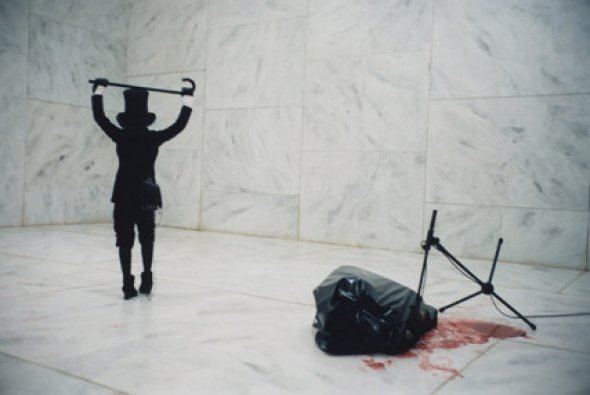
By the end of the 1980s, the group had changed name again, to Società Raffaello Sanzio, then tweaked to the Latin Societas. The name refers to artist Raphael (full Italian name Raffaello Sanzio), reflecting the group members’ education and interest in the arts. The use of Societas (Society) was chosen it indicate that they considered themselves a community, or Romeo Castellucci’s explanation “a community of strangers.”
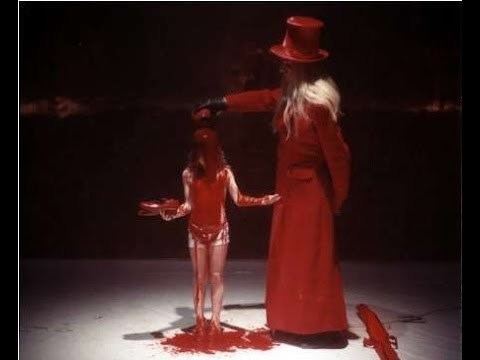
Their work of the first twenty years can be divided into three phases which correspond to three publications Teatro Iconoclasta (Iconoclastic Theater), Teatro della Super-Icona (Theater of the Super-Icon) and Epopea della plovers (Epic of Dust). During their first ten years, they were specifically interested in experimenting with different theatrical techniques and devices. Their work was based on ideas rather than dramatic texts, with the idea of making concepts material and communicating beyond language. For example, in La Generalissima, a new language was invented for one of the characters. Near the end of this period, they began adding non-human elements such as animals, either to represent something about a human character or an abstract concept. Early examples of this include Alla bellezza tanto antica (For Such Ancient Beauty - 1987), which had two pythons on the stage, followed by sheep, some goat and six baboons on the stage of La Discesa di Inanna (Inanna's Descent - 1989).
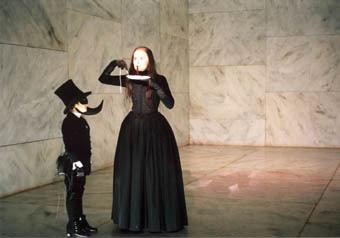
SRS had great impact on experimental theater companies in Italy in the 1990s such as Teatrino Clandestino, Fanny & Alexander, Impasto, Motus and Masque. By the 1990s, they were exploring myths such as Gilgamesh (1990) and descontructions of classics such as in Amleto (1992) and Julius Cesar (1997) .

Claudia Castellucci is one of main philosophers of the group who has written numerous articles and other texts since the 1980s, including theoretical pieces on how art and life inter-relate. The Oratorie (Oratories) were presented by SRS on stage in 1983. These ideas would be the basis of a collaboration between SRS and London-based theater teachers and critics Joe Kelleher and Nicholas Ridout to create a two-year, eleven episode series called Tragedia Endogonidia, produced between 2002 and 2004.
Tragedia Endogonidia expresses Claudia Castellucci’s basic theory, initially touched upon in early works, that it is necessary to negate traditional theater language as every detail of the performance implies and reflects the entire point of it, and make that point universal. The series was initiated in Cesena in January 2002 and ended there in December 2004, with intermediate episodes in cities such as Brussels, Rome, Strasbourg, London and Marseille, with the episodes loosely based on the location in which they were shown. This exploration of theatrical language of tragedy, continued into other works such as Il Combattimento (2000) with a focus on musical theater and Hey, Girl! (2006), which explored the use of gestures in cultures dependent on technology.
In 1989, their home base became what is now the Comandini Theater in Cesena. Until 2004, the Theater opened its doors sporadically to the public and only during SRS events. Since that year, the company has decided to open its doors to the city, with performances of other groups and hosting festival, beginine with the 2005/2006 season of the “Contemporary Theater.” In 2008, it hosted “Nature” and “Mantica” events that blend academics and performance with seminars, lectures, conferences and shows.
Artistry
The society is a community of artists who disdain the values of a world they feel they do not belong to. Individual members specialize in certain aspects of the production process, but have a say in all aspects of staging. According to Italian director Federico Tiezzi, Claudia Castellucci and Chiara Guidi are the intellectual soul of the company, with Romeo Castellucci and Paolo Guidi more in charge of its practical side. Despite their famous namesake’s use of physical perspective in his paintings, the company reject this as it “…makes you lose the internal perspective… Chiara Guidi explains that “We start from the presumption that superficial and pleasing things should not be done ... we must do something that hits, something that transforms.”
The group is part of a movement in Italian theater in the 1970s and 1980s, where members did not necessarily have a background in theater, but were influenced by rock music, poetry, comics, television, advertisement and movies to create works with strong visual impact, in which linear coherent narrative was absent most of the time. SRS is part of the second wave of this movement, along with Teatro della Valdoca and Albe, both founded in the same region two years after SRS.
SRS development was distinct from their contemporaries in that they widened the definition of theater, using fragmented works, artificial silence, violent sounds and haunting music, including children and animals in performances along with the simple presence of bodies marked by aging, anorexia, obesity and illness, as well as animals and even self-operaing machines as performers. The main idea behind the group is that theater is mostly based on the visuals and sound of the set. They also have worked to dismantle traditional theatrical language in order to create a new one, as well as to increase the audience’s awareness of the nature of the stage and human’s as “permanent spectators.”
Productions and venues
Venues aside from their own theater have included the Festival d’Avignon, the Hebbel Theater in Berlin, the Kunsten Festival des Arts, the International Festival Norway in Bergen, the Odéon Théâtre de l'Europe avec le Festival d'Automne in Paris, the Romaeuropafestival in Rome, Le Maillon Théâtre in Strasbourg, the London International Festival of Theater, Les Bernardines avec le Théâtre du Gymnase in Marseilles and the Festival Internacional Cervantino in Mexico.
Exhibitions include Rhetorica. Mene Tekel Peres, Bologna and Palermo, 2000; Uovo di bocca, Rome, 2001; To Cartage Then I Came, Festival d’Avignon, 2002 and Tempo incerto, Avellino, 2003.
Other projects
The company has also published a number of books which include Dal teatro iconoclasta al teatro della super–icona, Socìetas Raffaello Sanzio, (Ubulibri, Milano 1992), Uovo di bocca - scritti lirici e drammatici, Claudia Castellucci, (Bollati Boringhieri, Torino, 2000), Rhetorica - Mene Tekel Peres, Romeo Castellucci, (Aldo Grompone, Roma, 2000), L'epopea della polvere - Il teatro della Socìetas Raffaello Sanzio (Ubulibri, Milano, 2001), Les Pélerins de la Matière - Theorie et Praxis du Théâtre - Ecrits de la Socìetas Raffaello Sanzio (Les Solitaires Intempestifs, Besançon 2001), To Carthage then I Came, Romeo Castellucci, Claudia Castellucci, Joe Kelleher, Nicolas Ridout (Actes Sud, Arles, 2002) and The Theater of the Socìetas Raffaello Sanzio, Claudia Castellucci, Romeo Castellucci, Chiara Guidi, Jooe Kelleher, Nicholas Ridout, (Routledge, New York, 2007).
Videos by the group and members include Brentano, by Romeo Castellucci, (1995, 25'), Diario sperimentale della scuola infantile anno I, by Chiara Guidi, Romeo Castellucci and Stefano Meldolesi (1996, 58’), Diario sperimentale della scuola infantile anno II, by Chiara Guidi and Romeo Castellucci (1997, 49’), Genesi - from the Museum of Sleep, by Cristiano Carloni and Stefano Franceschetti (2000, 60’), Epitaph, by Romeo Castellucci (2000, 8’), Le Pélerin de la Matière, by Cristiano Carloni and Stefano Franceschetti (2000, 45’), Cesena, by Romeo Castellucci (2002, 25’), Avignon, by Cristiano Carloni and Stefano Franceschetti (2003, 27’ and Tragedia Endogonidia - Socìetas Raffaello Sanzio, by Romeo Castellucci, video by Cristiano Carloni and Stefano Franceschetti, music by Scott Gibbons (2007, 340,15').
The Cryonic Chants - Objective Songs And Poems, Taken From An Impassive Animal by Scott Gibbons and Chiara Guidi, with video by Romeo Castellucci, (2004, 50'), was a musical performance, the tour of which was documented and released as a live recording on enhanced CD by the Sonic Invaders imprint of KML Recordings in 2008.
Recognition
Their first award came in 1996 with the Special Ubu Prize for contributions to experimental theater. Since they have been awarded a number of awards including Premio Masque d’Or for Orestea, as best foreign performance of the year, Festival Theatre des Ameriques, Montreal, Quebec, 1997, Premio Europa Nuove Realtà Teatrali, Taormina, 2000, Best International Production for Genesi - from the Museum of Sleep, Dublin Theatre Festival, 2000 and Ubu Prizes for Genesi from the museum of sleep, as best performance of the year, 2000.
